Boak & Bailey put out the suggestion: “Let’s Go Long in September.” (Links to longform posts are here.) I love the concept and had hoped to post something original about Grodziskie here today. But I keep finding new information, and there’s constantly one more fact to check. So maybe that will a topic for “go long” in October, or November. Instead, I dug something I wrote for All About Beer magazine in 2009 off a backup drive. It’s related to one aspect of what intrigues me about the resurrection of ancient styles. Plus it’s interesting to see how the story has stood up to time.
Four thousand miles away from Manhattan in a northern Italian village Brifficio Troll owner Alberto Canavese was celebrating because his beers had just gone on sale in New York, New York. Only one of the particularly strong beers he shipped off, the 9% abv Palafrina brewed with chestnuts, was available in his own pub that day.
“This is what they want in America,” he said, happily.
His customers in Vernante might not understand, either that Americans brew such assertive beers or that America is also the world’s best market for bad ass beers from almost anywhere. Call it the Americanization of world beer or simply globalization, but the international beer landscape is changing. Not everybody agrees that’s good, but few dispute America is at the center.
In one of the last essays he wrote in 2007, the introduction to Beer: Eyewitness Companions, the late Michael Jackson argued that “tomorrow’s classics will evolve from a new breed of American brews that are categorized by their admirers as ‘Extreme Beers.’ These are the most intense-tasting beers ever produced anywhere in the world.”
British beer writer Adrian Tierney-Jones agrees. “The twenty-first century is definitely the American century in brewing terms-and I think it’s a good thing,” he said. “Beer is an international language, a language that crosses borders and at the moment the language we are hearing involves Brett, lots of hops, strong alcohol, hoppy barley wines, farmhouse ales with a twist-what is wrong with that?”
Daniel Shelton of Shelton Brothers Importers has an answer for Tierney-Jones. “It’s really sad to say the future is American beer when we haven’t perfected (brewing) the stuff from Europe yet,” he said. Shelton can be blunt, has a reputation for shooting from the hip and as an importer wouldn’t be expected to champion domestically brewed beers. However, many of the breweries he represents benefit because Americans are lapping up their bold, often intense, beers. Shelton is sincere when he talks about what he sees as dangers both within the United States and beyond.
Quite simply, if beer drinkers focus on the most exciting styles, if they measure the quality of a beer based on its intensity, then what happens to beers with nuance and to yesterday’s classics?
Even though beer never should be called “the new wine,” a quick bit of grape history seems relevant. In 1976 upstart California wines outscored classic French wines in a contest now called “The Judgment of Paris.” The tasting not only validated the quality of California wine, but convinced vintners from Australia to South Africa to Argentina that great wine could be made beyond France.
A few years later a Maryland lawyer by the name of Robert Parker started his “Wine Advocate” newsletter, offering independent reviews at a time when many writers recommending wine were otherwise connected to the industry. He liked to say he made the system more democratic, although the real reason he became the world’s most prominent wine critic might have been because he instituted a numerical system for rating wines, one that since spilled over into beer.
American beermakers can point no “Judgment of Paris,” but their influence-whether it be larger breweries producing pale lagers or smaller breweries making something more flavorful-is also felt from Australia to Scandinavia to Argentina. “People had no model for modern small brewery success. Americans gave them that,” Shelton said.
James Watt, co-founder of the Scottish newcomer BrewDog, makes that clear. “For me the innovation in brewing in the USA . . . has been by far the most exciting thing to happen in brewing, possibly ever. We wanted to take some of that excitement, some of that innovation, some of that boundary-pushing pioneering mentality and take it back to the UK,” he said.
However . . . we very much wanted to put our own spin and own identity onto our beers. I think we maybe copied the mindset and the innovation but our beers are certainly all of our own.”
No single critic for beer emerged like Parker. Jackson chose a different path, as much an anthropologist as critic. “I think the motivation was almost like the motivation of some of those musicologists like Alan Lomax who went down to the Mississippi Delta in the ’50s and recorded old blues men before they died,” he said in an interview in this magazine’s 100th issue. “I tracked down the styles and hoped that by writing about them I might help to keep them alive.”
Instead Internet websites Rate Beer and Beer Advocate-others as well, but none attract as many users as those two-began aggregating scores entered by members and assigning Parker-like numbers to beers and imposing their own democracy. Beer Advocate since changed to a letter grade, although it continues to publish “best of” lists. Brewers value these numbers just as much as winemakers cherish high scores from Parker.
Those opposed to numbers for wine and all things Parker complain that many vintners abandoned rustically styled wines for modern powerful “fruit forward” (and simpler) ones that would earn high ratings and seller at higher prices. During the course of 20 years the average alcohol content of Australian white wines rose from 12 to 13 percent, while reds climbed from 13 to 14 percent. In California Cabernet Savignons grew about one percent per year stronger starting in the mid-1970s, from the 12 percent to 15-plus, with Zinfandels reaching 17-plus.
Likewise stronger beers, often hoppier beers, continue to gain popularity in America. According to Information Resources Inc. the fastest growing style in the first half of 2009 was India Pale Ale. The rating sites certainly reward the biggest, boldest beers with the highest scores. At the end of 2008 Beer Advocate magazine compiled a “best of” list based on ratings at its website. North American breweries produced 17 of the top 25 beers, 24 of 25 of them 6% abv or more, most much stronger (8.5% abv on average).
Tierney-Jones took a good look at those numbers as he and a corps of writers chose the beers for a book, 1001 Beers You Must Taste Before You Die, he is editing for publication next March. “You could argue that they demonstrate the growing Americanization of beer culture in certain places in the world,” he said. “There are IPAs and imperial stouts from Italy, South Africa, Mexico, Argentina, Canada and even the Czech Republic; Australian beers that open their arms to Brett; British beers . . .”
Evan Rail, a native Californian now living in Prague who wrote the Good Beer Guide Prague & the Czech Republic, sees the American effect from both sides. “One is that what people call ‘Eurobeers’-the bland, mass-produced pale lagers-seem to be getting even more bland,” he said. “It’s not just the Americans anymore: a lot of the big European beers are really like having sex in a canoe.” On the flip side, he added, more European brewers are going in the opposite direction, pushing for more flavor.
“In countries where the indigenous beer culture had mostly been swept away-Denmark is a good example-American-style brewing has made big inroads,” said Ron Pattinson, who writes one of the Internet’s best read beer blogs from his home in Amsterdam. “But, I would expect beers there to gradually move away from American beers in style and establish their own identity.”
In Italy, Birra Del Borgo founder Leonardo Di Vincenzo brews beers with ingredients such as spelt unique to the region east of Rome where he lives, gentian root and tobacco, but also ones bittered with American hops. He exports several of these beers to the United States, but he does not brew them with that in mind. “I took the American market as an example to follow but I also am confronted with an Italian one that is totally different,” he said.
Like any good Roman he retains a personal appreciation of the classics. “Drinkers are asking for that (bold beers) a lot, but I’m sure that after this trend passes the classical will be more appreciated by beer lovers and drinkers,” he said. “I do worry that the classical are underrated in this moment and that’s a pity.”
Di Vincenzo, 33, looks like you expect an Italian brewer to, charismatic and swarthy, with a constant seven o’clock shadow. He would be an instant star at an American beer festival. He’s been to Delaware to brew a collaboration beer with Sam Calagione at Dogfish Head Craft Brewery and to Brussels to make one at Cantillon. Such partnerships create cross cultural exchanges between brewers that seldom existed a few years ago.
“I’ve always been passionate about learning how other brewers are doing things,” said Mitch Steele of Stone Brewing, a frequent collaborator. Not long ago Stone brewed a black pilsner called Juxtaposition with BrewDog and Cambridge Brewing in Massachusetts. “For all at BrewDog, having Greg (Koch), Steve (Wagner) and Mitch over and brewing with is pretty much like a crazy music fan being able to go on stage and rock out with their favorite band,” Watt, 27, said.
Bill Covaleski, co-founder of Victory Brewing in Pennsylvania, took part in one of the first. In 2002 he brewed a version of Victory’s HopDevil Ale as a collaboration at the Viennese brewpub “1516” (the name refers to Germany’s brew purity law, the Reinheitsgebot), and it’s been on tap almost constantly since. Victory began exporting beer to England, Ireland and Denmark in 2009. “We’re serious about Europe,” he said. Overall American craft brewery exports grew 25 percent in 2008, with shipments up 16 percent to Europe and more than 50 percent to Asia.
Even when locals aren’t drinking these new-fangled American ales those beers make their presence felt. Covaleski studied at brewing school in Bavaria and knows the European beer culture well. He appreciates what could be lost, but also what could be gained. He’s a fan of traditional (he’d suggest a capital ‘T’) low alcohol cask-conditioned British ales, but not at all bothered to taste modern versions containing American hops. “It’s a good trend. It allows them additional freedom,” he said. “Otherwise it’s like asking a kid to draw a picture with eight crayons instead of the whole box.”
Pattinson pulls no punches when he tastes American hops he doesn’t like, such as citrusy Northwest varieties in imperial stouts. He easily recognizes an Americanized beer. “Most definitely yes. Basically taking a style, substituting Amercian hops, doubling the hopping rate, upping the alcohol by 50 percent. Is it good or bad? Depends on your point of view,” he said. “Personally, I find many American beers dull precisely because of the way the style has been Americanized. The move towards basically just two types of beer: pale, strong and hoppy;
dark, strong and hoppy.”
Shelton shares similar concerns. “At some point you have to decide what beer has to be. You need a coherent philosophy,” he said. “Beer should be something you can drink a lot of.” He points to lower-alcohol English ales as just one of many examples of beer that could be bulldozed. “It is getting harder and harder to find the great stuff,” he said.
BrewDog makes aggressive beers and Watt isn’t shy about criticizing the “stuffy UK scene” but he disagrees with Shelton. “I think there is a place for all type of beers. The craft beer category is vibrant and growing but it would be wrong to assume that all drinkers joining the revolution are going to find their preference in the more extreme beers,” he said. “Some will naturally prefer the more balanced styles. Classics are classic for a reason, they have withstood the tests of time and will continue to do so.”
No two countries are the same. In Germany, the magazine Brauwelt and the Association of Small Private Breweries last March invited a dozen brewers to present special beers at a seminar. For instance, Hans-Peter Drexler from Weissbierbrauerei Schneider & Sohn talked about the strong and hoppy Schneider-Brooklyner Hefe-Weisse he brewed in collaboration with Garrett Oliver of Brooklyn Brewery. Eric Toft-a Wyoming native who has been brewmaster at Private Landbrauerei Schönram for 11 years-served Saphir Bock, his well-hopped 8% abv pale bock. “The ‘Bier-Quer-Denker’ is a group of brewers who look beyond standard styles and flavors to embrace the beer culture and styles of other countries,” Toft explained.
In the Czech Republic, American influence shows itself in top-fermented ales with Northwest hops. “Really, in the land of Saaz, did you ever think you’d taste beers made with Cascade or Chinook?” Rail asked.
He pointed out that Czech craft brewing includes the rediscovery of the styles that existed before Communism (and before that Nazi occupation). “Czech breweries are now going back and discovering beer styles that were produced here in the country’s ‘golden age’ of the 1920s and 1930s, as well as earlier beer styles like doppelbocks and Baltic porters,” he said. “Kout na Šumavě’s rich and chocolaty 18-degree dark lager is a great example. That development is not so much about Americanization as it is a very real ‘return to normalcy,’ meaning European beer normalcy.”
Pivovar Kout na Šumavě opened in 2006, mostly brewing classic hoppy, grainy pale lagers not far from the Czech-German border where traditional beers thrive, including Zoigl (community) beers from Bavaria’s Oberpfalz region and the eclectic variety available in the Franconian countryside around Bamberg.
“Zoigl and other German odditites are much more likely to be threatened by social change within Germany than new beer styles developed elsewhere,” Pattinson said. Matthias Trum, who oversees production of the Schlenkerla smoked beers, agrees. “At the moment it is good for us, but 30 years ago it was a tough time in Germany for such a beer.”
Trum’s family has owned the Heller Bräu brewery and Schlenkerla tavern for six generations, using 100 percent malt smoked over beechwood logs at the brewery to make Schlenkerla Rauchbier Märzen and Urbock. At 5.4% and 6.6% abv respectively neither qualifies as strong by American standards nor are they hoppy. But they are intense. Trum talked about the education of young beer drinkers in Bamberg, how they must learn to appreciate smoky beers. He paused when asked if, based upon Jackson’s suggestion “Extreme Beers” might be defined by their intensity, he would call his beers “Extreme.”
Trum slips easily into a discussion of history. For his thesis at brewing school he presented a paper on the historical depictions of guild signs as symbols, such as the six-point brewer’s star. Sitting in a tavern with roots that go back to the fourteenth century perspective comes naturally to him.
“If you were to call these Extreme then they’ve always been Extreme, this was the first wave,” he said. “We don’t make a fashion, like Coca Cola has. I see a danger if you are only a fashion.”
At Schlenkerla globalization means the rest of the world has discovered a localized way of brewing beer. In Fraserburgh, Scotland, where BrewDog opened in 2007, it means something else.
“I see the craft beer movement as global,” BrewDog’s Watt said. “I think there will soon be more and more examples of progressive boundary pushing brewers popping up all over the world. American craft brewers are not trying to Americanize beer, they are trying to make the best beer they can and for me there is a huge difference.”
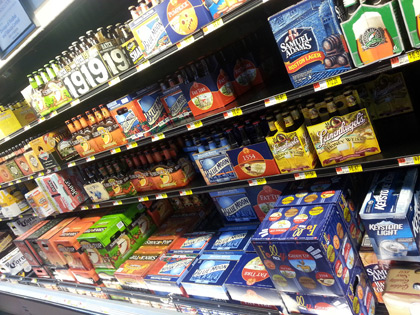
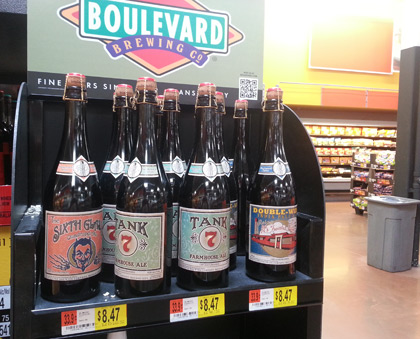
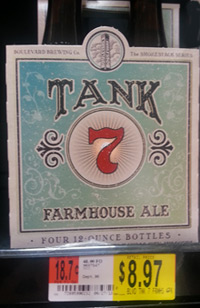 The price at Walmart includes the cost per ounce, making comparisons easy. At Walmart, at least now, this is mostly a matter of comparing packs of 6, 12, 18, 24 and 30. But — for those who don’t have the Beer Cost Calculator app on their phone that a 750ml bottle of Tank 7 from Boulevard costs 33.9 cents per ounce while a 4-pack of Tank 7 costs just 18.7 cents per ounce could be a revelation. The 750 of Tank 7 costs $8.47 at Walmart and $8.99 at Schnucks (the 4-packs $8.97 and $10.99, with a note at Schnucks that was .70 off the regular price — I usually pay $10.99 at my local beer store).
The price at Walmart includes the cost per ounce, making comparisons easy. At Walmart, at least now, this is mostly a matter of comparing packs of 6, 12, 18, 24 and 30. But — for those who don’t have the Beer Cost Calculator app on their phone that a 750ml bottle of Tank 7 from Boulevard costs 33.9 cents per ounce while a 4-pack of Tank 7 costs just 18.7 cents per ounce could be a revelation. The 750 of Tank 7 costs $8.47 at Walmart and $8.99 at Schnucks (the 4-packs $8.97 and $10.99, with a note at Schnucks that was .70 off the regular price — I usually pay $10.99 at my local beer store).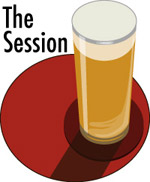 Host Derek Harrison at It’s Not Just The Alcohol Talking has announced the topic for The Session #80:
Host Derek Harrison at It’s Not Just The Alcohol Talking has announced the topic for The Session #80: 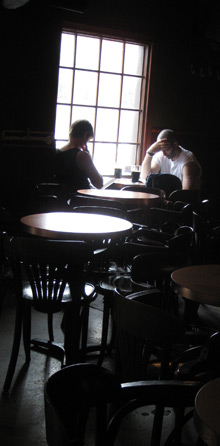 Are beer drinkers in
Are beer drinkers in